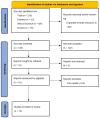The Upper Limb Orthosis in the Rehabilitation of Stroke Patients: The Role of 3D Printing
- PMID: 38002380
- PMCID: PMC10669460
- DOI: 10.3390/bioengineering10111256
The Upper Limb Orthosis in the Rehabilitation of Stroke Patients: The Role of 3D Printing
Abstract
Stroke represents the third cause of long-term disability in the world. About 80% of stroke patients have an impairment of bio-motor functions and over half fail to regain arm functionality, resulting in motor movement control disorder with serious loss in terms of social independence. Therefore, rehabilitation plays a key role in the reduction of patient disabilities, and 3D printing (3DP) has showed interesting improvements in related fields, thanks to the possibility to produce customized, eco-sustainable and cost-effective orthoses. This study investigated the clinical use of 3DP orthosis in rehabilitation compared to the traditional ones, focusing on the correlation between 3DP technology, therapy and outcomes. We screened 138 articles from PubMed, Scopus and Web of Science, selecting the 10 articles fulfilling the inclusion criteria, which were subsequently examined for the systematic review. The results showed that 3DP provides substantial advantages in terms of upper limb orthosis designed on the patient's needs. Moreover, seven research activities used biodegradable/recyclable materials, underlining the great potential of validated 3DP solutions in a clinical rehabilitation setting. The aim of this study was to highlight how 3DP could overcome the limitations of standard medical devices in order to support clinicians, bioengineers and innovation managers during the implementation of Healthcare 4.0.
Keywords: 3D printing; Healthcare 4.0; disability; neurologic disease; stroke.
Conflict of interest statement
The authors declare no conflict of interest.
Similar articles
-
An evaluation of 3D printable elastics for post stroke dynamic hand bracing: a pilot study.Assist Technol. 2023 Nov 2;35(6):513-522. doi: 10.1080/10400435.2023.2177774. Epub 2023 Feb 28. Assist Technol. 2023. PMID: 36780423 Free PMC article.
-
Three-Dimensional Printing in Medical and Allied Health Practice: A Literature Review.J Med Imaging Radiat Sci. 2020 Sep;51(3):489-500. doi: 10.1016/j.jmir.2020.06.003. Epub 2020 Jun 30. J Med Imaging Radiat Sci. 2020. PMID: 32620524 Review.
-
Personalized upper limb orthosis necessitates variety of tools during the development process: hemiplegic child case study.Disabil Rehabil Assist Technol. 2021 Feb;16(2):188-195. doi: 10.1080/17483107.2019.1646820. Epub 2019 Jul 30. Disabil Rehabil Assist Technol. 2021. PMID: 31361170
-
Utilization of 3D printed orthoses for musculoskeletal conditions of the upper extremity: A systematic review.J Hand Ther. 2023 Jan-Mar;36(1):166-178. doi: 10.1016/j.jht.2021.10.005. Epub 2021 Nov 21. J Hand Ther. 2023. PMID: 34819255
-
Three-dimensional printing: review of application in medicine and hepatic surgery.Cancer Biol Med. 2016 Dec;13(4):443-451. doi: 10.20892/j.issn.2095-3941.2016.0075. Cancer Biol Med. 2016. PMID: 28154775 Free PMC article.
Cited by
-
Surgical Medical Education via 3D Bioprinting: Modular System for Endovascular Training.Bioengineering (Basel). 2024 Feb 19;11(2):197. doi: 10.3390/bioengineering11020197. Bioengineering (Basel). 2024. PMID: 38391683 Free PMC article.
References
-
- Marotta N., Ammendolia A., Marinaro C., Demeco A., Moggio L., Costantino C. International Classification of Functioning, Disability and Health (ICF) and Correlation between Disability and Finance Assets in Chronic Stroke Patients. Acta Biomed. 2020;91:e2020064. doi: 10.23750/abm.v91i3.8968. - DOI - PMC - PubMed


